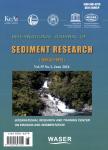Experimental investigation of the effects of shrub filter strips on debris flow trapping and interception
Experimental investigation of the effects of shrub filter strips on debris flow trapping and interception作者机构:Key Laboratory of Mountain Hazards and Earth Surface Processes Chinese Academy of Sciences Institute of Mountain Hazards and Environment Chinese Academy of Sciences University of Chinese Academy of Sciences Pipe China Southwest Pipeline Company Key Laboratory for Forest Ecosystem Process and Management College of Forestry Fujian Agriculture and Forestry University Department of GIS-RS and Watershed Management Maybod Branch Islamic Azad University
出 版 物:《International Journal of Sediment Research》 (国际泥沙研究(英文版))
年 卷 期:2023年第38卷第2期
页 面:265-278页
核心收录:
学科分类:0709[理学-地质学] 0819[工学-矿业工程] 08[工学] 0818[工学-地质资源与地质工程] 0708[理学-地球物理学] 0837[工学-安全科学与工程] 0816[工学-测绘科学与技术]
基 金:supported by the National Science Fund for Distinguished Young Scholars of China (Grant No. 41925030) the National Natural Science Foundation of China (Grant No. 41790434) the Youth science and technology fund of Institute of Mountain Hazards and Environment (IMHE Youth S&T Fund) Chinese Academy of Sciences (Grant No. SDS-QN-2108)
主 题:Ecological engineering Mountain hazards mitigation and prevention Shrub filter strips Debris flow Sediment trapping
摘 要:Ecological engineering plays an increasingly significant role in mountain hazard control, but the effect of species selection and arrangement(e.g., row spacing and stem spacing) on debris flow suppression is still unclear. To further understand the interception efficiency of shrub arrangement parameters on debris flow and explore the difference with slow hydraulic erosion, sixteen sets of small-scale flume experiments with different stem and row spacings were done to study the effects of shrubs on debris flow severity, flow rate, velocity, and particle size. The results suggest that, for a dilute debris flow, sediment interception effectiveness(27.4%-60.9%) decreases gradually as stem spacing increases. Moreover, as row spacing increases, flow velocity reduction(34.4%-44.9%) and flow reduction(18.5%-47.4%) gradually decrease; and the bulk density reduction(0.5%-5.3%) and sediment interception increase initially and then decrease. In contrast, for a viscous debris flow, the flow reduction, flow velocity reduction, and sedimentation interception decrease gradually as the stem spacing increases. As row spacing increases,the flow velocity reduction, flow reduction, and sediment interception all increase initially and then decrease. A formula for the flow velocity of dilute debris flow after the filter strip was derived based on the energy conservation law and Bernoulli’s equation, confirming that debris flow movement is closely related to the degree of vegetation cover. This research strengthens the current understanding of the effectiveness of vegetation in debris flow disaster prevention and control and can guide practical applications.



